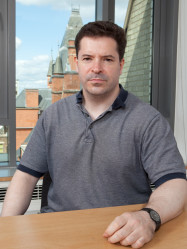Overview
My academic interests are in general Computational Fluid Dynamics (including multi-phase flow, oceanography and geophysical fluid dynamics), nuclear safety, optimisation, numerical research, including parallel solution techniques, recurrent and feed-forward neural networks, a priori error measures and mesh adaptivity, discretisation techniques, resolution of linear and non-linear equations, non-linear dynamics, numerical shape description and differential geometry. I am the original author of general purpose parallel Computational Fluid Dynamics code Fluidity (a foundation of the majority of my groups research activity), with mesh adaptive multi-phase and ocean modelling features. Inverse modelling has included anisotropic electrical inversion, 3D seismic inversion and inversion of transient 3-D coastal flows using the adjoint method.
PhD Students Graduated
2000 - Dr Shahriar Mansoorzadeh
2002 - Dr Akash Lal, Dr Jorg Herwanger, Dr Jefferson Gomes, Dr Geeta Chari, Dr Jason Bowsher
2003 - Dr Tom Bentham, Dr Matthew Eaton
2005 - Dr Philip Power, Dr Gerard Gorman, Dr Jon Saunders, Dr Hongbin Hong, Dr Tom Bentham
2006 - Dr Andrew Buchan
2007 - Dr Lucy Brichenon
2008 - Dr Sabu Brian, Dr James Milner, Dr Adam Candy, Dr Martin Wells
2009 - Dr Victoria Burnard, Dr Shan Xu, Dr Peter Hopcroft, Dr Julian Millian, Dr Patrick Farrell
2010 - Dr Dimitrious Pavladis
2011 - Dr Bryan Miles, Dr Brendan Tollit, Dr Negah Ardjmandpour
2012 - Christopher Baker, Simon Merton, Simon Jewer
Model Developments by C. Pain
- First working anisotropic mesh adaptivity method that is based on optimization methods which revolutionized computational physics.
- Developed one of the first parallel mesh adaptivity methods which is being extended for massive parallelization by combining MPI and OpenMP.
- The first general conservative mesh to mesh interpolation approach.
- Designed the dynamic core of Fluidity (e.g. Fluidity-ICOM) and the Boltzmann transport solver RADIANT.
- Developed new element types: the revolutionary new finite element P1DG-P2 for large scale geophysical fluid flows; new sub-grid-scale SGS finite elements for radiation transport and fluid flow
- Developed a new multi-grid method that scales independent of aspect ratio for Fluidity-ICOM and large scale fluid flows.
- Developed the 1st wetting and drying method that uses a highly implicit shared pressure-free surface variable.
- The first use of goal based mesh adaptivity for ocean flows.
- Developed the first robust material tracking method based on the use of compressive advection methods to maintain material boundaries.
- Developed the Independent Set Perturbation ISP adjoint method to radically simplify the formation of adjoints (for sensitivity analysis) for complex problems.
- Discovered a surprisingly benign bevaiour of criticality in plutonium solutions with positive temperature coefficients
- The first to discover the physics behind high frequency oscillations in fission rate and pressure observed in nuclear criticality experiments, which was due to oscillatory expansion and contraction of masses of raditiolytic gas bubbles.
- Obtained the most rigorous understanding of criticality in fissile solutions and new medical isotope reactors.
- Developed the immersed body approach for solid fluid coupling with conservation between fluid and solid forces on fully unstructured meshes
- The original author of models which have had a major impact: Fluidity (CFD); RADIANT (Boltzmann transport solver); FETCH (Finite Element Transient Criticality) coupled multi-phase flow and nuclear radiation model.
Example Projects
NERC – Natural Environment Research Council, UK
Next Generation' unstructured mesh ocean global circulation modelling.
Global Ocean Modelling with Adaptive Unstructured Grid Methods.
Better understanding of Open Ocean Deep Convection (OODC).
Open Ocean Deep Convection using a next generation ocean model.
Boundary separation using adaptive finite elements.
Development of an oceanographic model using 3D finite elements.
EPSRC - Engineering and Physical Sciences Research Council, UK
Advanced new methods for multi-scale free surface regional ocean modelling with adjoint data assimilation.
Realising the Commercial Potential of the Multi-Physics and Multi-Scale FETCH Technology for Nuclear Safety Applications.
Understanding air pollution in urban environments DAPPLE.
Data assimilation into inverse adjoint topography conforming coastal oceanographic models.
ERC
Flow Behaviour Characteristics during LOCA-type Accidents - A FETCH Study of Off-Normal Passive DHR with Structural Damage under Accidental Conditions (European Gas Cooled Fast Reactor (GoFastR) Programme).
MBase: The Molecular Basis of Advanced Nuclear Fuel Separations.
ITF - Industry Technology Facilitator: Three dimensional seismic imaging.
British Energy plc: Optimal refuelling of AGR nuclear power stations.
NIREX/NDA: Understanding criticality in nuclear wastes.
ABBD: Electrical resistance tomography for oil well logging.
HSE (NII): Understanding OKLO - a natural nuclear reactor.

